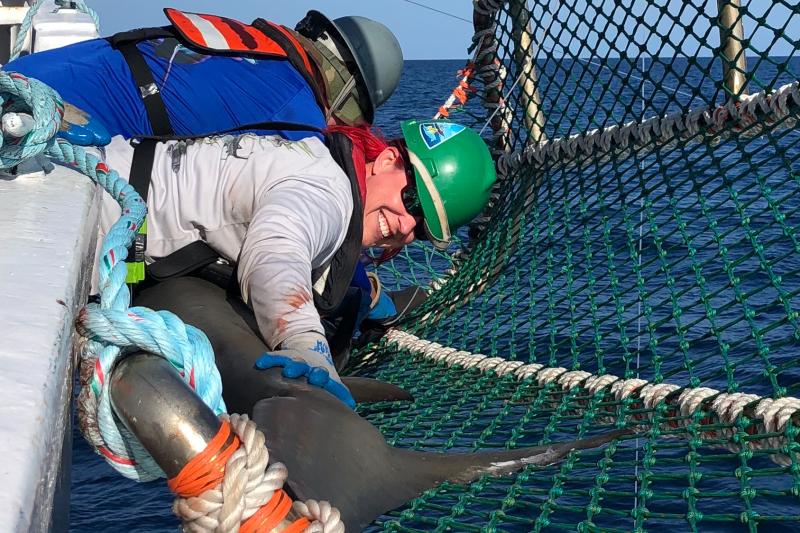Where did you grow up?
I grew up in Falls Church, Virginia, about 30 minutes (at least it used to be) outside of Washington, D.C.
Where did you go to school and in what subject did you get your degree(s)?
I went to Virginia Tech and earned a Bachelor of Science in biology with a minor in chemistry. I also studied abroad at James Cook University in Australia. I took a break from school after graduation, then I earned a master’s degree in marine sciences at the University of South Alabama. My thesis work examined the life history of chimaeras—soft-bodied, shark-like fish—in the Gulf of Mexico and deepwater biomass of cartilaginous fish-like chimeras and sharks.
How did you come to work at the Southeast Fisheries Science Center?
I took a winding path of exploring different opportunities within the marine science field and making connections that wound its way to Mississippi. My first experience with NOAA was actually working as a temporary contractor with the Northwest Fisheries Science Center on a marine mammal cruise in Alaska. This opened my eyes to opportunities in NOAA, which led to an internship with the Shark Population Assessment Group in Panama City, Florida. It was through that internship that I learned about the surveys conducted by the Southeast Fisheries Science Center. I had always wanted to participate in a scientific survey of that scale. I volunteered for both the Shark/Red Snapper Bottom Longline survey and SEAMAP trawl survey, even taking time off work to volunteer. Shortly after my second volunteer stint while pursuing a graduate degree, a cooperative position became available to work at NOAA. Since I had just been accepted into the graduate program at University of South Alabama, it was a good fit and got me started. That position thankfully evolved past my graduate work into my current position.
What do you do at the science center?
My work primarily supports stock assessment needs. I monitor the abundance and distribution of, and provide life history information for, several coastal shark and fish species throughout the Gulf of Mexico and southeast Atlantic. My work has thankfully given me the opportunity to work on a range of projects—including age and growth, reproduction and diet examinations, and taxonomy and gear selectivity. My primary responsibility is organizing and participating in the annual Bottom Longline Survey. This year will be my 16th year participating on the survey, having started as a volunteer and sailing the last decade as a field party chief. I have been lucky to be involved in all aspects of the survey. I have also participated in most of the center’s long-term surveys so I have been able to be involved in work from plankton collection to trawls, to marine mammal surveys.
What do you like most about your position?
A large part of the reason I wanted to work for NOAA is the applied nature of our work. I enjoy the responsibility of working to provide the best available data, being involved in the stock assessment process, seeing the tangible results of our work, and engaging with the community. Long-term survey work can become routine, as it is designed to be conducted the same way, year after year. But, the large amount of data collected also provides the opportunity to look at a diverse range of research questions. Being at sea for long periods of time year after year and away from your home and family can be challenging, but it offers an awesome chance to have unique insight and knowledge of the data. Every year, I look forward to the chance to work up close and personal with shark species that fascinated me when I was a kid and pushed me toward this field. I feel very lucky that I have the opportunity to have spent so much hands-on time with these animals.
What advice would you have for someone interested in a career at NOAA Fisheries?
Get involved and try everything, even if you don’t think it is exactly where you ultimately want to be working or the kind of work you might be interested in. I had no idea what I was looking for in this field initially. I am glad that I took the time to explore a lot of different options, be it internships, volunteer, or paid positions. I worked in aquariums, as an observer, at universities, I worked on projects from lingcod diet composition to humpback whale breeding ecology. All the experiences helped me further refine the kind of questions I was interested in, broaden my knowledge and skill set, and figure out what kind of work I was most suited for. Plus, it was a lot of fun along the way.
Is there a book, quote, or person that influenced you to be the person that you are today? Tell us why.
Jaws, both the movie and book, was very influential. I was terrified and fascinated. Wanting to learn more about sharks just led me down the rabbit hole. I still love the movie and have a poster of Quint in my office.
What do you like to do outside of work?
I did not grow up celebrating Mardi Gras, but since moving to the Gulf Coast, I have wholeheartedly embraced it. I joined a Mardi Gras krewe a few years ago and crossed off what I thought was just going to be a bucket list item riding on a float in New Orleans—an activity I will now be doing indefinitely. When I’m not glittering, crafting, or costuming for Mardi Gras, I like seeing live music, baking unnecessarily complex cakes and rainbow bagels, re-growing kitchen scraps, adopting house plants, playing with my mini-pitties, and traveling with my husband and family.






